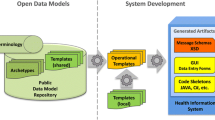Abstract
The use of Electronic Healthcare Records (EHR) standards in the development of healthcare applications is crucial for achieving the semantic interoperability of clinical information. Advanced EHR standards make use of the dual model architecture, which provides a solution for clinical interoperability based on the separation of the information and knowledge. However, the impact of such standards is biased by the limited availability of tools that facilitate their usage and practical implementation. In this paper, we present an approach for the automatic generation of clinical applications for the ISO 13606 EHR standard, which is based on the dual model architecture. This generator has been generically designed, so it can be easily adapted to other dual model standards and can generate applications for multiple technological platforms. Such good properties are based on the combination of standards for the representation of generic user interfaces and model-driven engineering techniques.











Similar content being viewed by others
References
El 70% de las primeras consultas en Primaria es susceptible de resolverse con las TIC (Last accessed on September 2011). http://directivos.publicacionmedica.com/noticia/el-70-de-las-primeras-consultas-en-primaria-es-susceptible-de-resolverse-con-las-tic.
Chen, R., Klein, G., Sundval, E., Karlsson, D., and Ahlfeldt, H., Archetype-based conversion of EHR content models: pilot experience with a regional EHR system. BMC Med. Inform. Decis. Mak. 9:33, 2009.
epSOS European eHealth project (Last accessed on September 2011). http://www.epsos.eu/.
Farzandipour, M., Ahmadi, M., Sadoughi, F., and Karimi irajk, I., Adopting confidentiality principles for electronic health records in iran: A delphi study. I. J. Med. Syst. 35:333, 2011. doi:/10.1007/s10916-009-9370-x.
Grams, R., The Obama EHR Experiment. J. Med. Syst. 1–6, 2010. doi:/10.1007/s10916-010-9559-z.
Jian, W., Hsu, C., Hao, T., Wen, H., Hsu, M., Lee, Y., Li, Y., and Chang, P., Building a portable data and information interoperability infrastructure - framework for a standard Taiwan Electronic Medical Record Template. Comput. Methods Programs Biomed. 88(2):102, 2007.
Lin, C. H., Lin, I. C., Roan, J. S., and Yeh, J. S., Critical factors influencing hospitals adoption of hl7 version 2 standards: An empirical investigation. J. Med. Syst. 1–10, 2010. doi:/10.1007/s10916-010-9580-2.
Palacio, C., Harrison, J., and Garets, D., Benchmarking electronic medical records initiatives in the US: a conceptual model. J. Med. Syst. 34:273, 2010. doi:/10.1007/s10916-008-9238-5.
ISO 13606 standard (Last accessed on September 2011). http://www.iso.org/iso/home.htm.
OpenEHR specification (Last accessed on September 2011). http://www.openehr.org/home.html.
Health Level Seven (Last accessed on September 2011). http://www.hl7.org.
Stroetmann, V. N., Kalra, D., Lewalle, P., Rector, A., Rodrigues, J. M., Stroetmann, K. A., Surjan, G., Ustun, B., Virtanen, M., and Zanstra, P. E., Semantic Interoperability for Better Health and Safer Healthcare. Deployment and Research Roadmap for Europe. ISBN-13:978-92-79-11139-6, 2009.
Beale, T., Archetypes: Constraint-based Domain Models for Future-proof Information Systems. In: Baclawski, K., and Kilov, H. (Eds.) Eleventh OOPSLA Workshop on Behavioral Semantics: Serving the Customer. Boston: Northeastern University, pp. 16–32, 2002.
Kalra, D., and Archana, T., The EHR and Clinical Archetypes: time for clinical engagement! In: eHealth Planning and Management Symposium. Copenhagen, Denmark, 2008.
Good European Health Record (GEHR) project (Last accessed on September 2011). http://www.chime.ucl.ac.uk/work-areas/ehrs/GEHR/index.htm.
OpenEHR Foundation. ADL language (Last accessed on September 2011). http://www.openehr.org/releases/1.0.1/architecture/am/adl2.pdf.
Schuler, T., Garde, S., Heard, S., and Beale, T., Towards automatically generating graphical user interfaces from openEHR archetypes. Stud. Health Technol. Inform. 124:221, 2006. http://view.ncbi.nlm.nih.gov/pubmed/17108529
XML User Interface Language (Last accessed on September 2011). https://developer.mozilla.org/en/xul.
Nardon, F., França, T., and Naves, H., Construção de Aplicações em Saúde Baseadas em Arquétipos. In: XI CBIS, 2008.
OpenEHR Template Designer, Ocean (Last accessed on September 2011). http://wiki.oceaninformatics.com/confluence/display/TTL/Template+Designer.
Opereffa (Last accessed on September 2011). http://opereffa.chime.ucl.ac.uk/introduction.jsf.
Brass, A., Moner, D., Hildebrand, C., and Robles, M. Standardized and Flexible Health Data Management with an Archetype Driven EHR System (EHRFlex). In: Seamless Care-Safe Care. The Challenges of Interoperability and Patient Safety in Health Care. Proceedings of the EFMI Special Topic Conference. Amsterdam: IOS Press BV, pp. 212–218, 2010.
LiU archetype editor (Last accessed on September 2011). http://www.imt.liu.se/mi/ehr/tools/.
der Linden, H. V., Austin, T., and Talmon, J., Generic screen representations for future-proof systems, is it possible?: There is more to a GUI than meets the eye. Comput. Methods Programs Biomed. 95(3):213, 2009.
Fernández-Breis, J. T., Menárguez-Tortosa, M., Moner, D., Valencia-García, R., Maldonado, J. A., Vivancos-Vicente, P. J., Miranda-Mena, T., and Martínez-Béjar, R., An Ontological Infrastructure for the Semantic Integration of Clinical Archetypes. Lect. Notes Comput. Sci. 4303:156, 2006.
OWL Web Ontology Language Reference (Last accessed on September 2011). http://www.w3.org/tr/owl-ref/.
Martínez-Costa, C., Menárguez-Tortosa, M., T. Fernández-Breis, J., and Maldonado, J. A., A model-driven approach for representing clinical archetypes for Semantic Web environments. J. Biomed. Inform. 42(1):150, 2009.
MOFScript. http://www.eclipse.org/gmt/mofscript/ (Last accessed on September 2011).
Object Management Group. Model driven architecture guide (Last accessed on September 2011). http://www.omg.org/cgi-bin/doc?omg/03-06-01.
Beydoun, G., Low, G., Mouraditis, H., and Henderson-Sellers, B., A security-aware metamodel for multi-agent systems. Inf. Softw. Technol. 51(5):32, 2009.
XForms (Last accessed on September 2011). http://www.w3.org/TR/xforms11/.
RichFaces site (Last accessed on September 2011). http://www.jboss.org/richfaces.
The Seam Framework (Last accessed on September 2011). http://seamframework.org/.
PrimeFaces site (Last accessed on September 2011). http://www.primefaces.org/.
The WebKit open-source project (Last accessed on September 2011). http://www.webkit.org/.
Examples of applications generated with ArchForms (Last accessed on September 2011). http://miuras.inf.um.es/∼researchehr/archforms.html.
W3C Markup Validation Service (Last accessed on September 2011). http://validator.w3.org/.
EN 13606 Association (Last accessed on September 2011). http://www.en13606.eu.
Acknowledgement
This work has been possible thanks to the Spanish Ministry for Science and Education through grant TIN2010-21388-C02-02.
Conflict of interest
The authors declare that they have no conflict of interest.
Author information
Authors and Affiliations
Corresponding author
Rights and permissions
About this article
Cite this article
Menárguez-Tortosa, M., Martínez-Costa, C. & Fernández-Breis, J.T. A Generative Tool for Building Health Applications Driven by ISO 13606 Archetypes. J Med Syst 36, 3063–3075 (2012). https://doi.org/10.1007/s10916-011-9783-1
Received:
Accepted:
Published:
Issue Date:
DOI: https://doi.org/10.1007/s10916-011-9783-1




